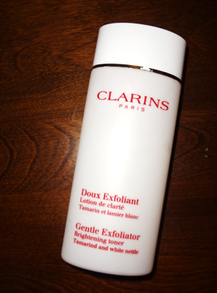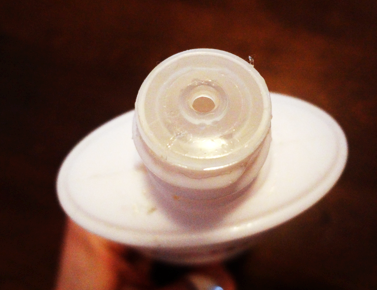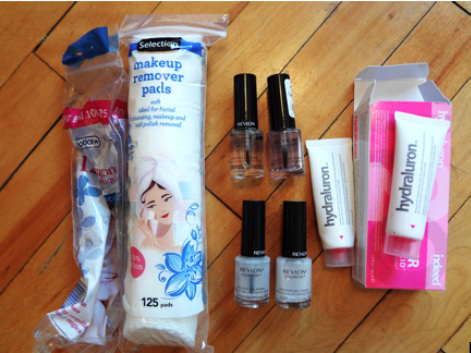Introduction In my last skincare post, I presented a beginner's guide to one of 2013's latest skincare crazes, the use of alphahydroxy acids (AHA) and betahydroxy acids (BHA) as a means of removing excess dead skin cells on the surface of your skin, revealing brighter skin, minimizing aging effects, helping with acne and hyperpigmentation. If you want to know the basics on both chemical exfoliants and how they differ from each other and traditional scrubs, then I would read that first here.After learning about all of the benefits of chemical exfoliation, it was hard not to fall into the hype myself. When it comes to skincare in the internet beauty community, there are definite trends that arise. Caroline Hirons is a UK-based, seasoned, cosmetic consultant and trained facialist, who has a blog where she shares many witty reviews and skincare guidelines. Back in May, the Pixiwoo sisters interviewed Caroline for their Body Talk Daily channel, where she recommended a ton of skincare must-haves, including the frequent use of a chemical exfoliant in one's skincare routine. She specifically recommended the Biologique Recherche P50 toner, which uses a combination of lactic acid (AHA) and salicylic acid (BHA). Unfortunately, this exfoliator is both (1) expensive and (2) not really available in Canada, to my knowledge. Therefore, for my first foray into the world of chemical exfoliation, I looked into finding a gentle AHA that had been generally well-reviewed online. While searching the blogosphere, I repeatedly found rave reviews of the Clarins Gentle Exfoliating Brightening Toner, which was pretty expensive at $31.00 CAD for 125mL, but still reasonable compared to other AHA/BHAs. I kept almost buying it at Shopper's Drugmart (Canadian drugstore) when I would drag my mother there, until Debs finally just picked it up for me one afternoon (thanks mom!). AHA: Clarins Gentle Exfoliating Brightening Toner As with the Biologique Recherche P50, this exfoliating toner contains a combination of behatydroxy and alphahydroxy acids, specifically: tartaric (AHA), glycolic (AHA), and salicylic (BHA) acids. However, the amount of acids present in the Clarins toner is significantly less when compared to the the Biologique Recherche and many other exfoliators on the market. As such, I thought it would serve as a great pilot test for chemical exfoliation, in case I experienced any sort of adverse reaction (I know I'm supposed to still do a spot test on my arm, but I decided my un-sensitive skin could handle the low acid levels).
This is what Clarins has written regarding application directions on the toner's packaging:
"Apply once or twice a week to a thoroughly cleansed face and neck with a cotton pad soaked in lotion. Avoid the eye contour area. Wait one minute before completing with your regular skin care routine." Now, when it comes to using active chemical exfoliants, cosmetic companies tend to be rather apprehensive with their product's directions, in order to avoid any potential lawsuits. I felt completely comfortable applying this toner daily, and did so at nighttime to a fully cleansed face, before continuing with some sort of moisturizing oil or lotion. The toner is transparent with a thick liquid consistency, and I simply applied it all over my face using a regular cotton pad. Additionally, I ensured that I was consistently applying SPF in my morning skincare routine, as glycolic acid is known for increasing your skin's photosensitivity (making your skin more susceptible for sun damage).
Introduction - The Exfoliation Trend Skincare-wise, 2013 definitely seemed like the year of exfoliation, more specifically the use of chemical exfoliants. For those of you furrowing your brows in confusion, let me explain: Exfoliation is the process by which you can remove built-up skin cells sitting on the surface of your skin; this can help with unclogging pores, preventing breakouts, improving skin texture and reducing aging effects. In short, exfoliation is an inexpensive skincare addition for any age and skin type! There are two types of exfoliants in skin care: - Physical exfoliants: otherwise known as "srcubs" and what is commonly associated with thoughts of exfoliation. Physical exfoliants are a fair option for exfoliating your skin (so long as the scrub is not too abrasive, as these can actually damage you skin's barrier). However, scrubs are also a less effective exfoliant option, given that they are only able to remove the very top layer of your skin, thus not properly removing all of the built-up skin cells clogging your pores. Some examples: cult-classic St. Ives Apricot Scrub + my preferred Neutrogena Deep Clean Gentle Scrub
- Chemical exfoliants: these sure took the beauty blogging world by storm this year, though they are really nothing new in terms of ingredients. Basically, chemical exfoliants are a more effective way to reap the benefits of exfoliation as they are capable of removing built-up skin cells that are causing dryness, blackheads, blemishes, wrinkles, etc., when compared to physical exfoliators. I am just about to finish up my first long-term chemical exfoliant, which was the Neutrogena Acne Stress Control 3-in-1 Hydrating Acne Treatment (gosh, what a mouthful) so more on that later...
Honourable mention: Exfoliating washcloths can also serve as physical exfoliants. Although these may help prevent abrasive scrubs from tearing into your skin, you should still always be gentle with a washcloth (especially around you eyes). Chemical Exfoliation As I mentioned, chemical exfoliants are all the rage in skincare these days, so I'll break it down for you. For credibility purposes, I'll leave the fancy scientific terminology to my skincare guru Paula Begouin (also knows at "the cosmetics cop"), who frequently reviews chemical exfoliants (and all other cosmetics) on the BeautyPedia reviews section of her website paulaschoice.com, and also sells some great options from her own line! Essentially, there are also two main varieties of chemical exfoliants: - Alpha Hydroxy Acids (AHAs): According to Paula, "AHAs are preferred for sun-damaged and dry skin because they exfoliate on the surface of skin and have the added benefit of also improving moisture content."* Some common forms of AHAs that are featured in many anti-aging cosmetics are glycolic acid, lactic acid, and citric acids. Note: glycolic acid has the smallest molecular size of any AHA, and therefore penetrates the skin most easily. AHAs are often used in professional chemical peels, though at higher levels than what you'd find in widely-available cosmetics. Although AHAs are usually found in products that target the anti-aging market, I (a nineteen year old) still went through an entire bottle of the popular Clarins Gentle Exfoliator Brightening Toner, and will be reviewing soon.
- Beta Hydroxy Acids (BHAs): BHAs are most commonly used in products targeted at the acneic/teenage market, especially in spot treatment gels, oil-absorbing toners, or prescription acne medication. The most common form of beta hydroxy acid is salicylic acid, which is fortunately widely available in well-priced drugstore products (good AHA products tend to run more expensive). Paula cites many great reasons to use a BHA exfoliant:
- "BHA is preferred for oily, acne-prone skin and for treating blackheads and white bumps because BHA can get through the oil that's clogging your pores, normalizing the lining of the misshapen pore that contributes to acne."*
- "BHA has anti-inflammatory and antibacterial action. Those are two more reasons to use a BHA exfoliant if you have acne or sensitive, reddened skin."*
- "BHA is preferred for those struggling with rosacea. Not everyone with rosacea can tolerate an exfoliant, but it is wise to experiment with a BHA product to see how your rosacea responds. It is quite likely you'll see less redness and a smoother, more even skin with fewer breakouts."*
As a beauty junkie, I too frequently buy into the latest claims, crazes, innovations and trends that arise with every season. That being said, there are certain items that I find myself repurchasing again and again, either because they are a necessity, or because I have yet to find a better replacement. Today, I will be sharing of few of these good ol' faithful beauty products that 1. Cotton Pads: You can rest assured that I will always buy another bag of these when I run out. Cotton pads, or "makeup removing pads," as these one are called, are amazing for applying toner to your face, and more gently removing stubborn black makeup under your eyes. However, I am not brand loyal to any particular brand/type of cotton pads, and usually buy whatever is cheapest/around when I run out. 2. Revlon Colorstay Base + Top Coat: Given how much I have grown to obsess over makeup, it is hard to believe that I used to not wear any (except the occasional mascara) or know anything about the entire realm until my senior year of high school. My first forray into extreme superficial girly-ness was with my obsessive nail polish hoarding around the tenth grade. Since 2008, I have barely spent a day with bare fingernails. However, I pride myself in the fact that my nails are still in good health, have no discoloration, and are usually chip-free. I have also tried out my fair share of base/top coats including Seche Clear + Seche Vite, OPI Ridge Filler, Sally Hansen Insta-Dry, Sally Hansen Diamond Strength, etc. After a long love affair with Seche, I have found my new holy grails, and that would be these gems my Revlon. They're easily accessible, relatively cheap, the colour lasts, my nails dry fast, and the finish is always super-glossy. I would highly recommend these to everyone, and also encourage you to check out the rest of the Revlon Colorstay nail line. 3. Hydraluron by indeed labs: Sometimes, you just gotta follow the pack, if just for investigative purposes (to see if a product can truly be as miraculous as it is made out to be). For those who have never heard of this product before, let me provide a brief synopsis: Hyaluronic acid (or sodium hyaluronate) is by no means a new skincare breakthrough or discovery. In fact, it has probably been somewhere in the ingredients list of several moisturizing products you've owned as it "can hold up to 1,000 times its weight in water" (whatever that means). However, hyaluronic acid is having a huge comeback, and indeedlabs is capitalizing on it by providing a no-frills, moderately priced, fragrance-free, and paraben-free "moisture booster" serum. A bit over a year ago, internet skin care guru Caroline Hirons sung her praises for hydraluron, and since then, almost every beauty blogger has also joined the fan club. Although the tube is little in size, it lasted me several months of near daily use. So is hydraluron worth the hype? To be honest, not really. I have not noticed some fabulous breakthrough in my skin while using this product, nor do I notice a grand difference on days that I go without it. Granted, this may be because my skin wasn't really all that dry or dehydrated to begin with (I just sort of assumed that the extra hydration couldn't hurt). Regardless, I still chose to repurchase it before I ran out, because (a) it is still well-priced when compared to other serums, (b) I actually got it on sale so that was tempting, (c) hyaluronic acid is a skin-identical ingredient proven to boost moisture content and prevent moisture loss *( source). For now, this will remain an ol' faithful serum under the yet to find a better replacement category.
|



 RSS Feed
RSS Feed